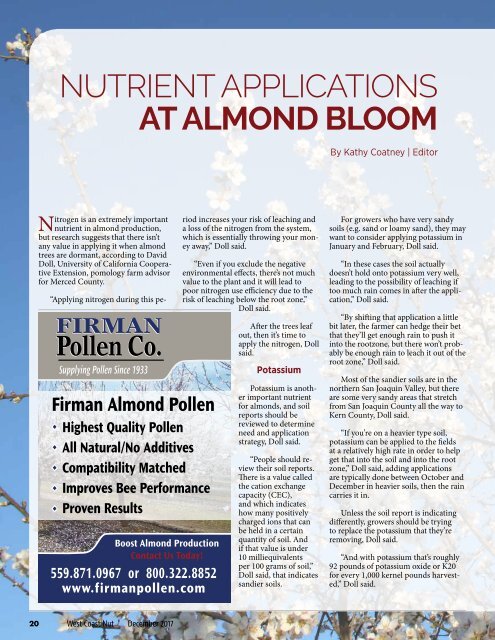WCN_Dec17WEB
You also want an ePaper? Increase the reach of your titles
YUMPU automatically turns print PDFs into web optimized ePapers that Google loves.
NUTRIENT APPLICATIONS<br />
AT ALMOND BLOOM<br />
By Kathy Coatney | Editor<br />
Nitrogen is an extremely important<br />
nutrient in almond production,<br />
but research suggests that there isn’t<br />
any value in applying it when almond<br />
trees are dormant, according to David<br />
Doll, University of California Cooperative<br />
Extension, pomology farm advisor<br />
for Merced County.<br />
FIRMAN<br />
Pollen Co.<br />
Supplying Pollen Since 1933<br />
Firman Almond Pollen<br />
.<br />
Highest Quality Pollen<br />
All Natural/No Additives<br />
Compatibility Matched<br />
Improves Bee Performance<br />
Proven Results<br />
Boost Almond Production<br />
Contact Us Today!<br />
559.871.0967 or 800.322.8852<br />
www.f irmanpollen.com<br />
“Applying nitrogen during this period<br />
increases your risk of leaching and<br />
a loss of the nitrogen from the system,<br />
which is essentially throwing your money<br />
away,” Doll said.<br />
“Even if you exclude the negative<br />
environmental effects, there’s not much<br />
value to the plant and it will lead to<br />
poor nitrogen use efficiency due to the<br />
risk of leaching below the root zone,”<br />
Doll said.<br />
After the trees leaf<br />
out, then it’s time to<br />
apply the nitrogen, Doll<br />
said.<br />
Potassium<br />
Potassium is another<br />
important nutrient<br />
for almonds, and soil<br />
reports should be<br />
reviewed to determine<br />
need and application<br />
strategy, Doll said.<br />
“People should review<br />
their soil reports.<br />
There is a value called<br />
the cation exchange<br />
capacity (CEC),<br />
and which indicates<br />
how many positively<br />
charged ions that can<br />
be held in a certain<br />
quantity of soil. And<br />
if that value is under<br />
10 milliequivalents<br />
per 100 grams of soil,”<br />
Doll said, that indicates<br />
sandier soils.<br />
For growers who have very sandy<br />
soils (e.g. sand or loamy sand), they may<br />
want to consider applying potassium in<br />
January and February, Doll said.<br />
“In these cases the soil actually<br />
doesn’t hold onto potassium very well,<br />
leading to the possibility of leaching if<br />
too much rain comes in after the application,”<br />
Doll said.<br />
“By shifting that application a little<br />
bit later, the farmer can hedge their bet<br />
that they’ll get enough rain to push it<br />
into the rootzone, but there won’t probably<br />
be enough rain to leach it out of the<br />
root zone,” Doll said.<br />
Most of the sandier soils are in the<br />
northern San Joaquin Valley, but there<br />
are some very sandy areas that stretch<br />
from San Joaquin County all the way to<br />
Kern County, Doll said.<br />
“If you’re on a heavier type soil,<br />
potassium can be applied to the fields<br />
at a relatively high rate in order to help<br />
get that into the soil and into the root<br />
zone,” Doll said, adding applications<br />
are typically done between October and<br />
December in heavier soils, then the rain<br />
carries it in.<br />
Unless the soil report is indicating<br />
differently, growers should be trying<br />
to replace the potassium that they’re<br />
removing, Doll said.<br />
“And with potassium that’s roughly<br />
92 pounds of potassium oxide or K20<br />
for every 1,000 kernel pounds harvested,”<br />
Doll said.<br />
20 West Coast Nut December 2017


















